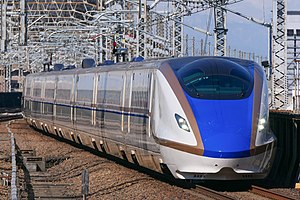| E7 & W7 series | |
|---|---|
 E7 series set F19 on an Asama service in February 2021 | |
| In service |
|
| Manufacturer |
|
| Designer | Ken Okuyama |
| Replaced | E2 series, E4 series |
| Constructed | 2013– |
| Number built | 852 vehicles (71 sets) (as of 17 January 2023[update]) |
| Number in service | 540 vehicles (52 sets) |
| Number scrapped | 120 vehicles (8 E7 sets, 2 W7 sets; flood damage) |
| Formation | 12 cars per set |
| Fleet numbers | F1–F47; W1–W24 |
| Capacity | 934 |
| Operators | JR East, JR West |
| Depots | Hakusan, Nagano, Niigata |
| Lines served | Hokuriku Shinkansen, Jōetsu Shinkansen |
| Specifications | |
| Car body construction | Aluminium alloy |
| Car length | 26 m (85 ft 4 in) (end cars) 25 m (82 ft 0 in) (intermediate cars) |
| Width | 3,380 mm (11 ft 1 in) |
| Height | 3,650 mm (12 ft 0 in) |
| Doors | 2 sliding doors per side |
| Maximum speed |
|
| Weight | approx. 540 t |
| Power output | 12 MW |
| Acceleration | 1.6 km/(h⋅s) (1.0 mph/s) |
| Electric system(s) | 25 kV 50/60 Hz AC catenary |
| Current collector(s) | Single-arm pantograph |
| Safety system(s) | DS-ATC, RS-ATC |
| Track gauge | 1,435 mm (4 ft 8+1⁄2 in) standard gauge |
| Notes/references | |
This train won the 58th Blue Ribbon Award in 2015. | |

The E7 series (E7系, E-nana-kei) and W7 series (W7系, Daburu-nana-kei) Shinkansen are Japanese high-speed electric multiple unit train types operated on the Hokuriku and Jōetsu Shinkansen lines, and jointly developed by East Japan Railway Company (JR East) and West Japan Railway Company (JR West) respectively.
The E7 series has operated since 15 March 2014 on the Hokuriku Shinkansen.[1][2] It also operates on the Jōetsu Shinkansen following the March 2019 timetable revision. 47 sets have been built, of which 39 are in service as of March 2024[update].
The W7 series has operated on the Hokuriku Shinkansen since it was extended from Nagano to Kanazawa in March 2015.[2] The first W7 series train was delivered in April 2014.[3] 24 sets have been built, of which 22 are in service as of March 2024[update].
- ^ 3月15日ダイヤ改正と各地の話題 [15 March timetable revision and topics from around the regions]. Tetsudō Daiya Jōhō Magazine (in Japanese). Vol. 43, no. 361. Japan: Kōtsū Shimbun. May 2014. p. 12.
- ^ a b "E7系・W7系新幹線電車" [E7/W7 series shinkansen EMU]. Japan Railfan Magazine. Vol. 52, no. 619. Japan: Koyusha Co., Ltd. November 2012. pp. 48–49.
- ^ Cite error: The named reference
hokkoku20140424was invoked but never defined (see the help page).